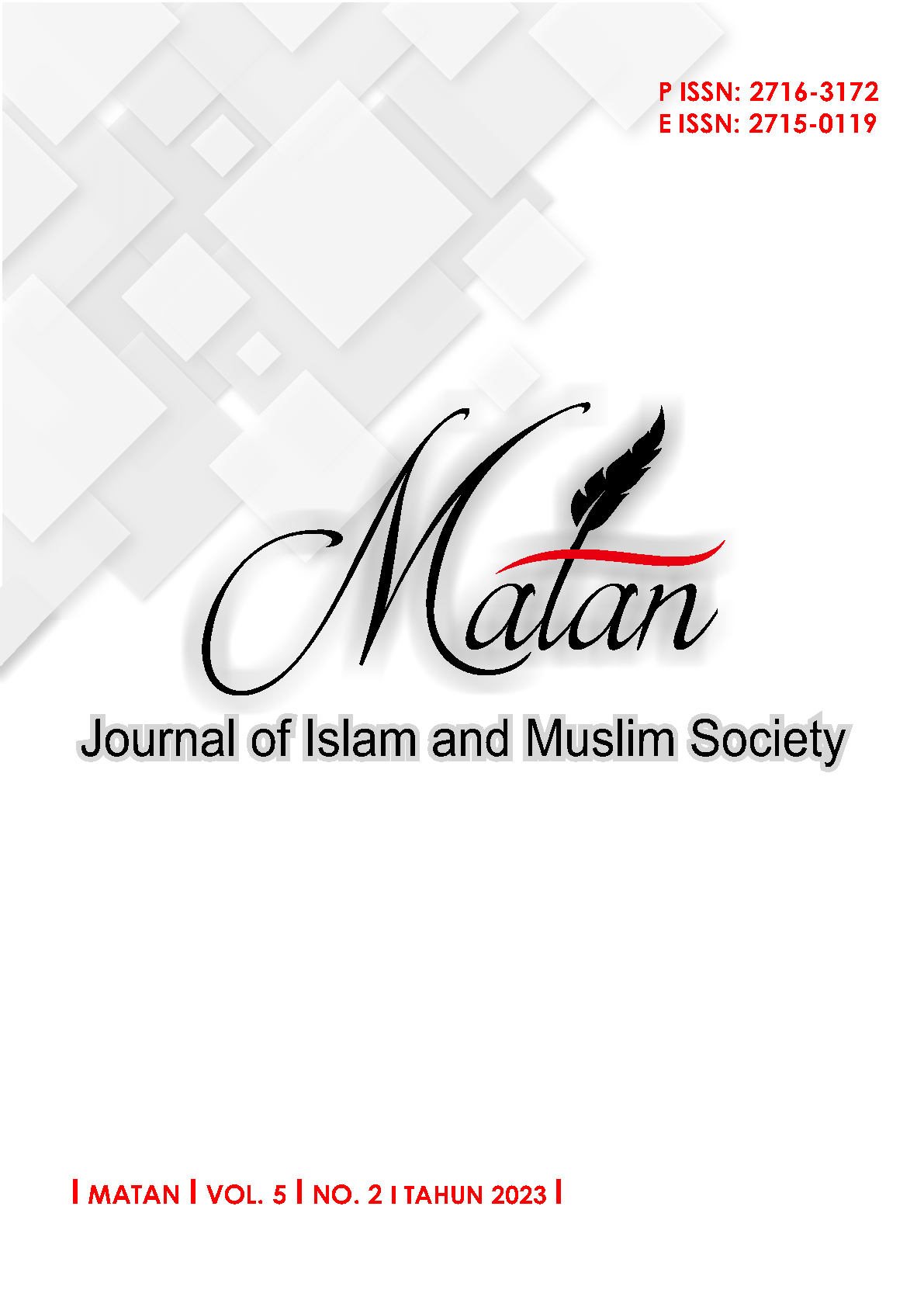Unifikasi Kelompok Keagamaan Islam Berbasis Multi Interdisipliner Menuju Masyarakat Madani
Abstrak
The purpose of this article is to reveal the problems of friction, conflict, and divisions that occur among Muslims, which are spread across several groups such as Nahdlatul Ulama, Muhammadyah, Jama'ah Islam, Tabligh Jama'ah, Salafi, and Ahmadiyah. In general, each group claims to be the appropriate group, so they are trapped in bigotry based on their group, doctrine, fatwa, or their leaders. The method of this study is library research in which the approach is carried out in a multi-disciplinary manner, namely through the science of interpretation, hadith, ushul fiqh, and sociology. The method of this study is based on library research in which the approach is carried out in a multi-disciplinary manner, namely through the science of interpretation, hadith, ushul fiqh, and sociology. The study's results found: 1) Islam highly upholds unity within the ummah. The prohibition of division has been imposed since the prophet's time before the Prophet Muhammad was revealed to the world. Therefore, the existence of religious groups should be to strengthen people and religion to try to avoid the perception of a single truth claim so as not to be trapped in the fanaticism of the group, schools of thought, fatwa, as well as towards their leaders; 2) Unification of religious groups can occur if it is based on intellectual awareness. This awareness can penetrate ideologies, schools of thought, and cultures. Without this awareness, unification is challenging to achieve; and 3) Intellectual awareness can be achieved through intellectual collaboration between religious group leaders. This intellectual awareness is a gateway to civil society, which has the characteristics of being open to knowledge, egalitarianism, and equality in the community, respecting human rights, respect for achievements, being highly civilized, and abandoning primordial attitudes.
Referensi
Abdulsyani, Sosiolog, Skema, Teori Dan Terapan (4th ed.). (Jakarta: Bumi Aksara, 2012).
Adibah, Ida Zahara, Pendekatan Sosiologis Dalam Studi Islam Dan. Jurnal Inspirasi, 1.I (2017), 1–20.
Afif Muhammad. Radikalisme Agama Agama Abad 21. AL JAMI’AH, Journal of Islamic Studies, 41.2 (2003), 309.
Abu Zahra an Najdi. Al Qur’an Dan Rahasia Angka Angka (terjemahan) (1st ed.), (Bandung: Pustaka Hidayah, 1991).
Andiko, Toha “Melacak Akar Konflik dalam Islam dan Solusi bagi Kerukunan Umat Beragam Di Indonesia.” Madania, XVII.1 (2013), 47.
Ash Shiddiqy, Hasbi, Pengantar Hukum Islam, Jilid II. (Jakarta: Bulan Bintang, 1981).
Astrid S. Susanto, Pengantar Sosiologi dan Perubahan Sosial, (Jakarta: Bina Cipta, 1985).
Azhari, Susiknan, Karakteristik Hubungan Muhammadiyah dan NU dengan Menggunakan Hisab Dan Rukyat. Al Jami’ah, Journal of Islamic Studies, 44.2 (2006), 454.
Bukhori, A. A. M. bin I. al. Shahih Al Bukhori. (Dar Ibn Katsir, 2002).
Danial dan Wasriah. Metode Penulisan Karya Ilmiah. (Bandung: Laboratorium Pendidikan Kewarganegaraan UPI, 2009).
Fianto, Jefri Adi, Representasi Peristiwa Kerusuhan Sunni Syiah di Sampang Madura Dalam Foto - Foto di Majalah Tempo Edisi 24 Agustus 2012-11 Agustus 2013. Commonline, 4.1 (2013), 162–172.
Gaffar, A, “Jamaah Ahmadiyah Indonesia (JAI) Dalam Perspektif Kekerasan Negara: Dua Kasus Dari Surabaya Jawa Timur dan Lombok NTB.” Jurnal Sosiologi Islam, 3.2 (2013), 31.
Gastil, J. W. The group in society. In The Group in Society (Issue January 2009), (2010). https://doi.org/10.4135/9781452274676
Hamka, Tafsir Al Azhar, jilid 2, (Singapura: Pustaka Nasional PTE LTD), hlm. 879.
Harnoko, Darto “Kerusuhan Situbondo Oktober 1996". Patrawidya, 12.4 (2011), 30.
Hidayat, Komarudin, Ketika Agama Menyejarah. AL JAMI’AH, Journal of Islamic Studies, 40.1 (2003). 54.
https://quran.kemenag.go.id/index.php/ tafsir/1/30/32
https://www.almaany.com/ar/ar-ar
Ibn Katsir, Imadudin Abil Fida Isma’il, Tafsir al Qur’an al ‘Adzim, Juz IV. (Semarang: Toha Putra).
Jacobs, Garyy, et al. Unification in the Social Sciences: Search for a Science of Society. Cadmus Journal.Org, 2.3 (2014), 31.
Löhnig, M., “Unification of law in the field of family law – roads and dead-end-roads.” International and Comparative Law Review, 12(2), (2012), 101–112. https://doi.org/10.1515/iclr-2016-0089
Majah. Ibnu, Sunan Ibnu Majah, juz 2.
Marijan, K. "Wajah Islam Nusantara”, Pengantar buku karya Aksin Wijaya, Menusantaraka Islam (Menelususri Jejak Pergumulan Islam yang Tak Kunjung Usai di Nusantara), (Jakarta: Kemenag RI).
Nata, A. Peta Keragaman Pemikiran Islam Di Indonesia. (PT Raja Grafindo Persada, 2001).
Puspitasari, Elis et al. Penguatan Image Pesantren sebagai Lembaga Pendidikan Anti Teroris Melalaui Pencanangan Website. HUMANIS, Jurnal Sosial Ekonomi Humaniora, 5.1 (2011).
Rahmat, Jalaludin, Islam Aktual, Refleksi Sosial Seorang Cendekiawan Muslim (3rd ed.), (Jakarta: Mizan, 1992).
Saleh, S. Stimulation of Changes, Collective Commitment and the Patterns of Group Formation in Community Development in South Sulawesi. IOP Conference Series: Earth and Environmental Science, 156.1 (2018). https://doi.org/10.1088/1755-1315/156/1/012015
Setiadi, Elly M., dan Kolip, Usman, Pengantar Sosiologi Pemahaman Fakta dan GejalaPermasalahan Sosial: Teori, Aplikasi, dan Pemecahannya. (Jakarta: Kencana Prenada Media Group, 2011).
Shihab, M. Quraish, Tafsir Al Misbah, Pesan, Kesan dan Keserasian Al Qur’an, (Banten: Lentera, Hati, 2017)
Suroto, Kosep Masyarakat Madani Indonesia dalam masa Postmodern (Sebuah Analitis Kritis). Jurnal Pendidikan Kewarganegaraan, 5.9 (2015). 42.
Suwarno, Peter, Resolving Religious Conflict Trough Expanding Inter-Religious Communication : Issues and Challenges. AL JAMI’AH, Journal of Islamic Studies, 43.2 (2005), 70.
Syakir, Munib bin Mahmud, Al ‘Amal bi Al Ihtiyaṭi fi al Fiqhi al Islamy, Juz 1. (Dar al Nafāis, 1998).
Taufan, Sabik Aji, Viral Peneliti BRIN Ancam Bunuh Warga Muhammadiyah Karena Beda Lebaran. (2023, April). 24. https://www.jawapos.com/nasional/01567382/viral-peneliti-brin-ancam-bunuh-warga-muhammadiyah-karena-beda-lebaran
Waskito, Abu Muhammad, Mendamaikan Ahlus Sunnah di Nusantara, Mencari Titik Kesepakatan antara Asy’ariyah dan Wahabiyah (I). (Jakarta: Pustaka Al-Kautsar, 2012).
Zed, M. Metode Penelitian Kepustakaan. (Yogyakarta: Yayasan Obor Indonesia, 2014).







